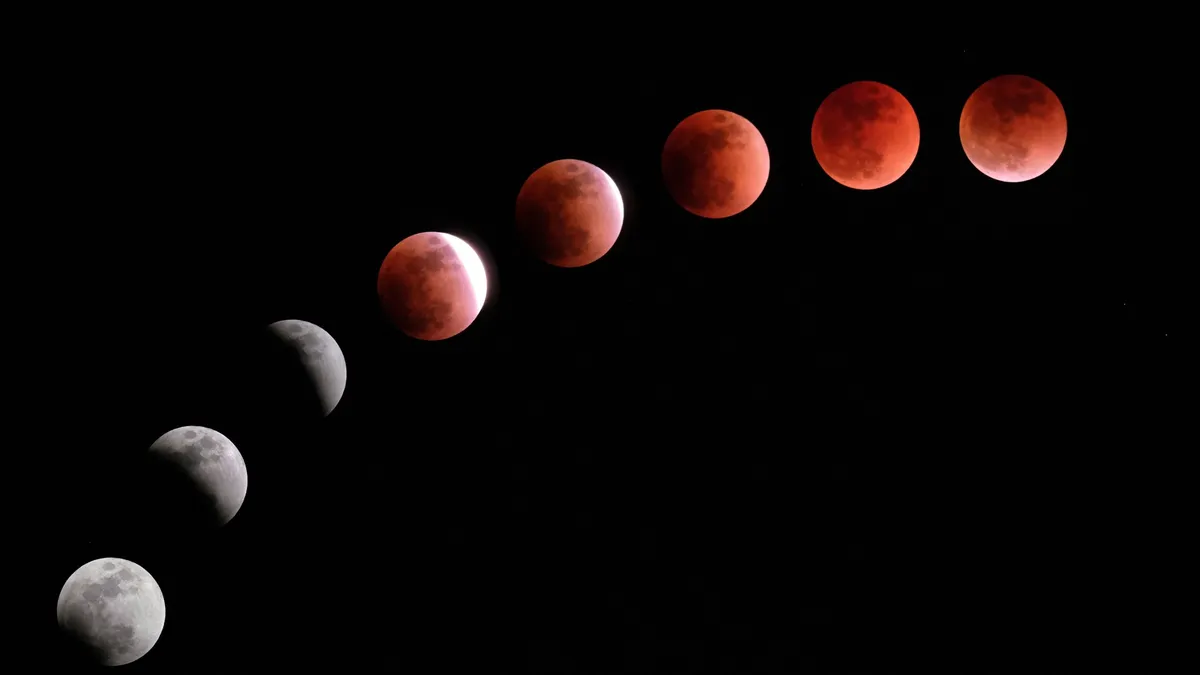
Skywatchers across the United States are in for a celestial treat tonight as the “Blood Worm Moon” takes center stage during a spectacular total lunar eclipse. This rare event will transform the moon into a stunning reddish hue, visible in most parts of North America. However, weather conditions may impact visibility in certain regions. Here’s everything you need to know about this extraordinary lunar phenomenon, including the best places to catch a glimpse.
The “Blood Moon” refers to the reddish appearance of the moon during a total lunar eclipse. This happens when Earth aligns perfectly between the sun and the moon, casting its shadow over the lunar surface. The reddish hue occurs because sunlight filters through Earth’s atmosphere, scattering shorter wavelengths like blue and green while allowing red and orange light to illuminate the moon.
March’s full moon is traditionally called the “Worm Moon,” signifying the end of winter and the start of spring. The combination of these two phenomena makes tonight’s event particularly special, earning it the nickname “Blood Worm Moon.”
The total lunar eclipse will begin late Thursday night and extend into Friday morning, depending on your location. Key times to note include:
-
: 1:26 a.m. Eastern Time (10:26 p.m. Pacific Time)
-
: 2:26 a.m. Eastern Time (11:26 p.m. Pacific Time)
-
: 3:31 a.m. Eastern Time (12:31 a.m. Pacific Time)
The period of totality, when the moon is fully immersed in Earth’s shadow, will last approximately 66 minutes.
Weather conditions play a crucial role in determining where you’ll get the best view of tonight’s eclipse. According to forecasts:
-
: Regions with clear skies include parts of the lower Great Lakes, Ohio Valley, Central Plains, and Texas. These areas are expected to have minimal cloud cover, offering uninterrupted views of the Blood Worm Moon.
-
: Scattered clouds may partially obstruct views in some locations, but large breaks in cloud cover could still allow periodic glimpses of the eclipse. This category includes parts of the Midwest and Southeast.
-
: Unfortunately, heavy cloud cover is expected along the Pacific Coast (Washington, Oregon, northern California), Gulf Coast (Louisiana, Mississippi, Alabama, Florida Panhandle), and parts of South Florida. Cities like New York, Boston, and Philadelphia may also face low cloudiness due to offshore weather disturbances sweeping in from the Atlantic Ocean.
If you’re located in one of these areas with poor visibility forecasts, consider driving inland to escape cloud cover for better viewing opportunities.
For those lucky enough to have clear skies tonight, simply head outside during peak eclipse hours and look up! If you’re planning to photograph the event, NASA experts recommend using long exposure settings on your camera and stabilizing it with a tripod for crisp images.
If weather conditions prevent you from seeing the eclipse in person, don’t worry—many online platforms will stream live coverage of the event. Websites like Space.com will provide real-time updates and visuals so you can still enjoy this celestial spectacle from anywhere.
For astrology enthusiasts, tonight’s Blood Worm Moon carries deeper meaning. As it transitions from Leo to Virgo during its journey across the sky, it aligns with prominent stars like Regulus and Spica. Virgo represents themes of responsibility and transformation—pairing this energy with the intensity of a full moon creates an ideal environment for personal growth and renewal.
Ancient cultures often viewed lunar eclipses as spiritual events. For example:
-
The Navajo used eclipses as moments for reflection and prayer.
-
The BaKongo people believed eclipses allowed communication with ancestors.
-
Medieval Crusaders interpreted eclipses as favorable omens for victory in battle.
Whether you choose to embrace these traditions or simply marvel at nature’s beauty, tonight’s event offers an opportunity for both awe and introspection.
If you miss tonight’s Blood Worm Moon due to weather or other reasons, don’t worry—another total lunar eclipse visible from North America is scheduled for March 3, 2026. However, tonight’s event remains one of the most striking celestial displays until then.
The Blood Worm Moon is more than just an astronomical event—it’s a reminder of nature’s ability to inspire wonder and connect us with something greater than ourselves. Whether you’re watching from clear skies or tuning into live streams online, this total lunar eclipse promises to be an unforgettable experience.
Good luck spotting this breathtaking phenomenon tonight!